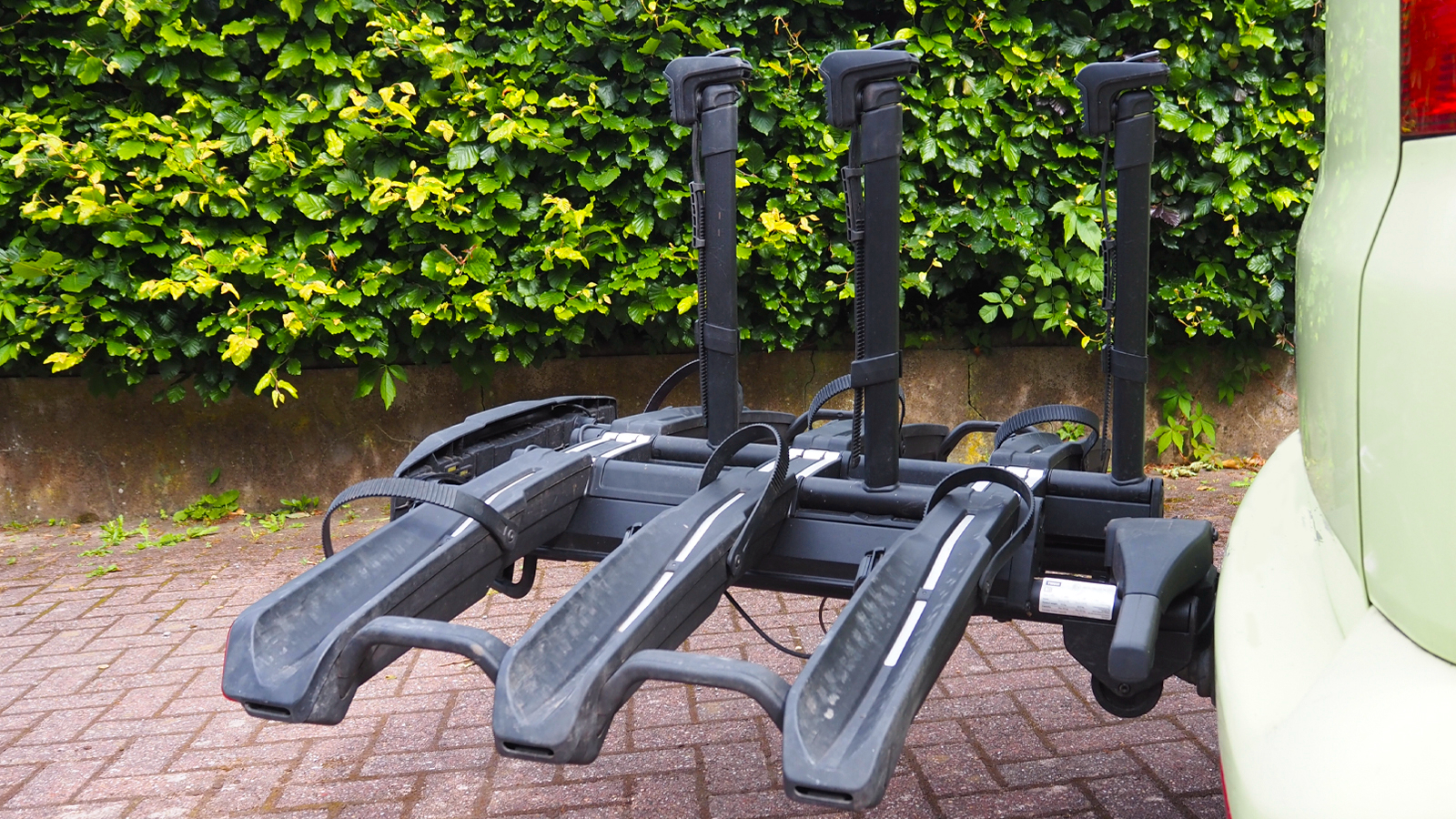
Thule has a wide range of bike carriers for all kinds of vehicles. I've been testing the Thule Epos – a towbar/hitch carrier that's substantial enough to handle bikes up to 30kg, so has plenty of capacity for even the heftiest electric mountain bikes.
The three-bike version here comes with inbuilt rear lights, but there is also a two-bike model – both are available without lights for a lower RRP. My test Epos carrier comes with a pretty hefty $1,099.99 / £1,099.99 / €1,099.99 price tag, so is it worth the investment, and is it the best bike hitch rack you can buy?
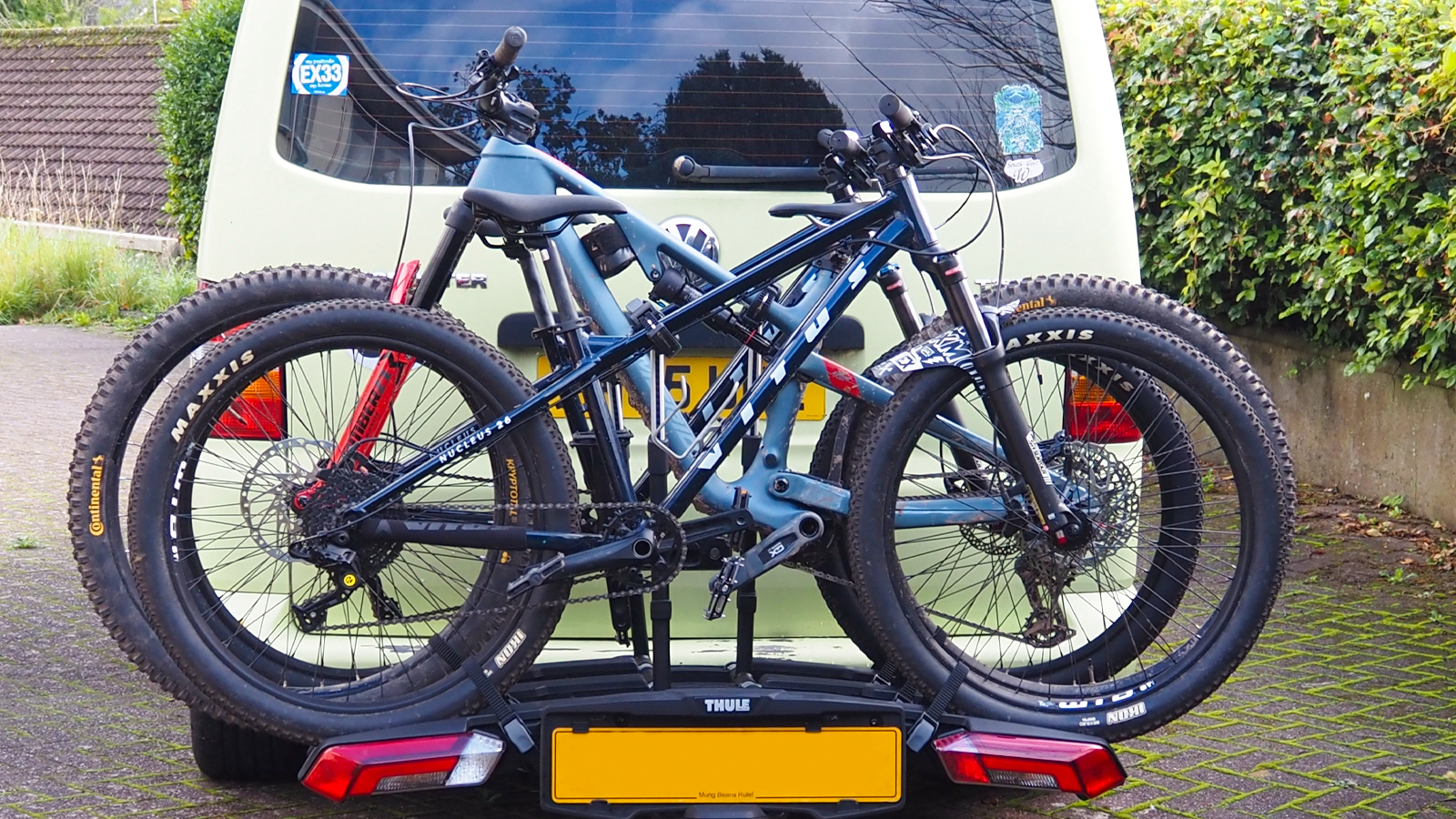
Design and specifications
With a maximum load capacity of 60kg, the Epos needs to be sturdily built and so it is with an aluminum paneled, steel tubed base and arms with steel lowers and aluminum upper sections. The resulting overall weight is 23.2kg for the three-bike model, which is about the same as the average full-power electric mountain bike. To make maneuvering the rack easier, Thule have added two small wheels to the heavier end.
Unlike most tow hitch racks, the Epos is foldable which makes fitting it in place much easier than its rivals (more on that later). Once locked in place (with a key that also locks the rack's arm straps), it's also tiltable which enables access to the rear of your vehicle with the rack still attached. The 'something-able' functions don't end there though – as the three arms used to secure the bikes are tiltable and extendable, with moveable and lockable heads. Steel-reinforced ratchet straps on the arms secure the bikes in place, along with the ratchet straps on each wheel.
While the three-bike Epos is capable of carrying 30kg bikes, the rack's 60kg maximum load means only carrying two full-fat e-MTBs – as weights are around 25kg per bike. The two-bike version has the same weight limit, so I'd make an educated guess that the 60kg maximum comes from how much weight you can safely suspend on your tow hitch.
The model I'm testing came with a full electrical pack. This plugged into my towbar electrics via a 13-pin plug giving full rear lighting on the rack.
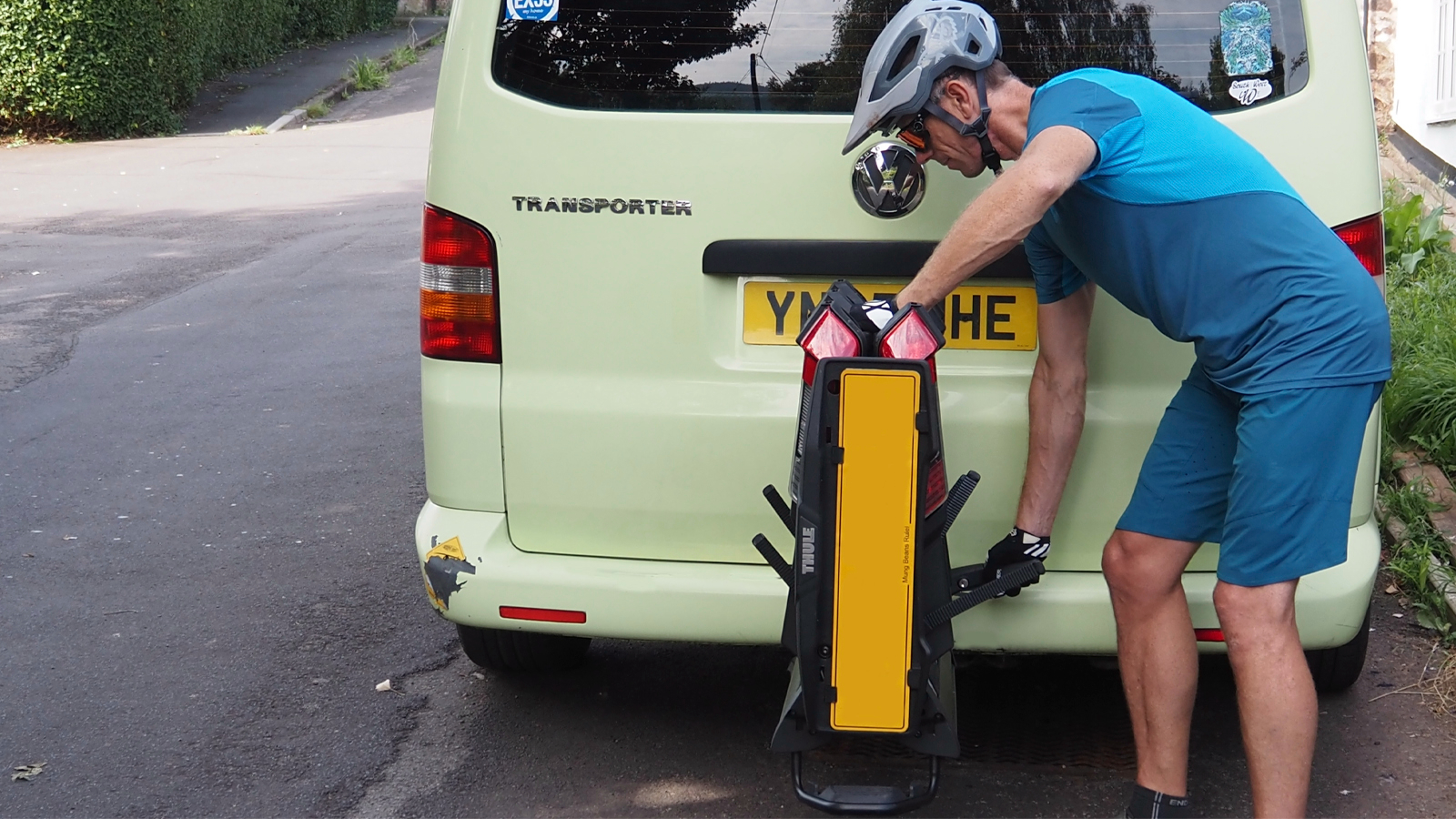
Performance and use
I've used a number of different bike tow hitch racks over the years, there are two main benefits over strap on racks that hook into your vehicle's rear shut lines: The lower position makes it easier to lift your bikes on and off, and by not being directly attached to your vehicle's body, your paintwork is less likely to get damaged. However, the big drawback with most hitch racks is that you have to bend down and reach forward over the rack to mount them to your tow ball. It's a manual handling fail that has given me a sore back many times.
I've been testing the Thuke Epos for a year now and the biggest advantage for me is its folding base which means you can fix the rack in place without breaking any safe lifting rules. It's easy to bend down next to the tow hitch to engage the handle on the rack's lockable coupling.
A low base height when fitted to my VW T5 Transporter van meant I had the option of rolling bikes onto the rack a wheel at a time when mounting – rather than having to lift them into place. While that's not such a big deal for conventional bikes, it definitely made life easier when loading heavy e-MTBs. While I've not tested it here, Thule also sells an additional loading ramp for the Epos for $59.99 / £59.99 / €59.99, which looks like it would make things easier still and the ramp can be neatly stowed away in the center of the rack when not in use.
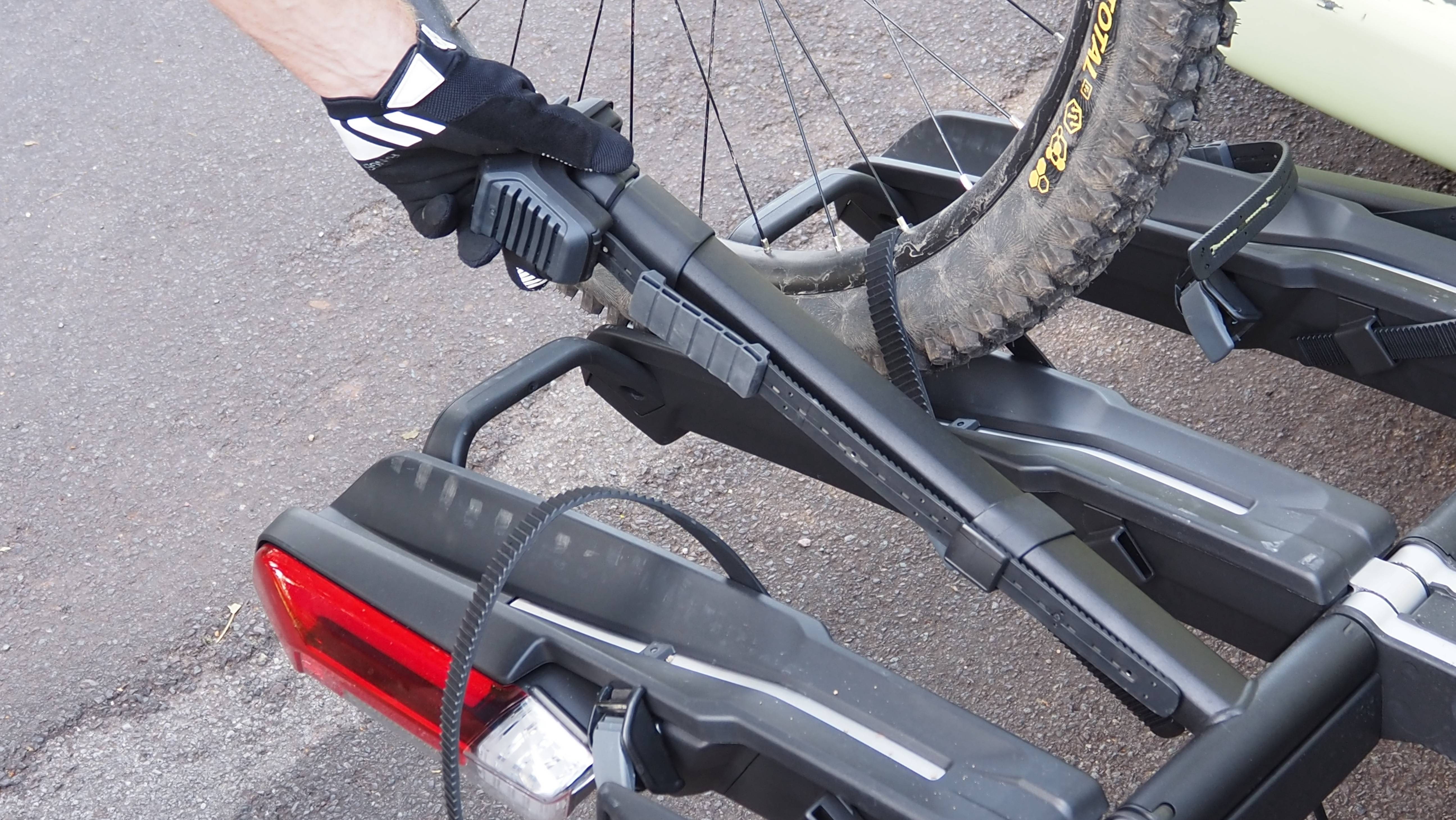
The adjustability of mounting arms makes securing bikes in place as straightforward as it gets. The extending length and tiltable heads are really useful and the rubberized concave indents in the heads means bikes are less likely to move around and scuff frame finishes – I've had none of this during testing. Thule states 25cm gaps between bikes, but that is actually measured from the center of each wheel slot, so the actual distance is more like 18cm. This still gives more room than most for fitting though and multiple bikes don't rub up against each other either – as long as you're careful where you position pedals, bars, etc. Being able to lock the mounting straps in place on the heads gives a degree of security too, and while the steel strips running through the straps are by no means impregnable to would-be thieves, they're more resistant to cutting than non-reinforced versions.

When fitting longer bikes nearer to the stated maximum length of 135cm, there wasn't a huge amount of wriggle room, so I had to make sure I balanced the wheels so the overhang was even on both sides. Officially the max tire width is 3in, but I ran tires up to 3.5in with no problems – you can upgrade to 5in tire capacity with the optional Thule XXL Fatbike Wheel Straps.
It's easy to tilt the rack for boot access, just press on the metal foot plate below the license plate. But while it works well for hatchback cars, there still wasn't enough clearance to fully open the tailgate on my van. I've had the same issue with all the tiltable tow hitch racks I've used though, so it's not just an issue here.
The Epos is heavier than most rivals and the trolley wheels are designed to make moving the rack easier. However, I found myself needing to bend to the side to wheel it along which felt a bit awkward, so just carrying was actually less of a strain.
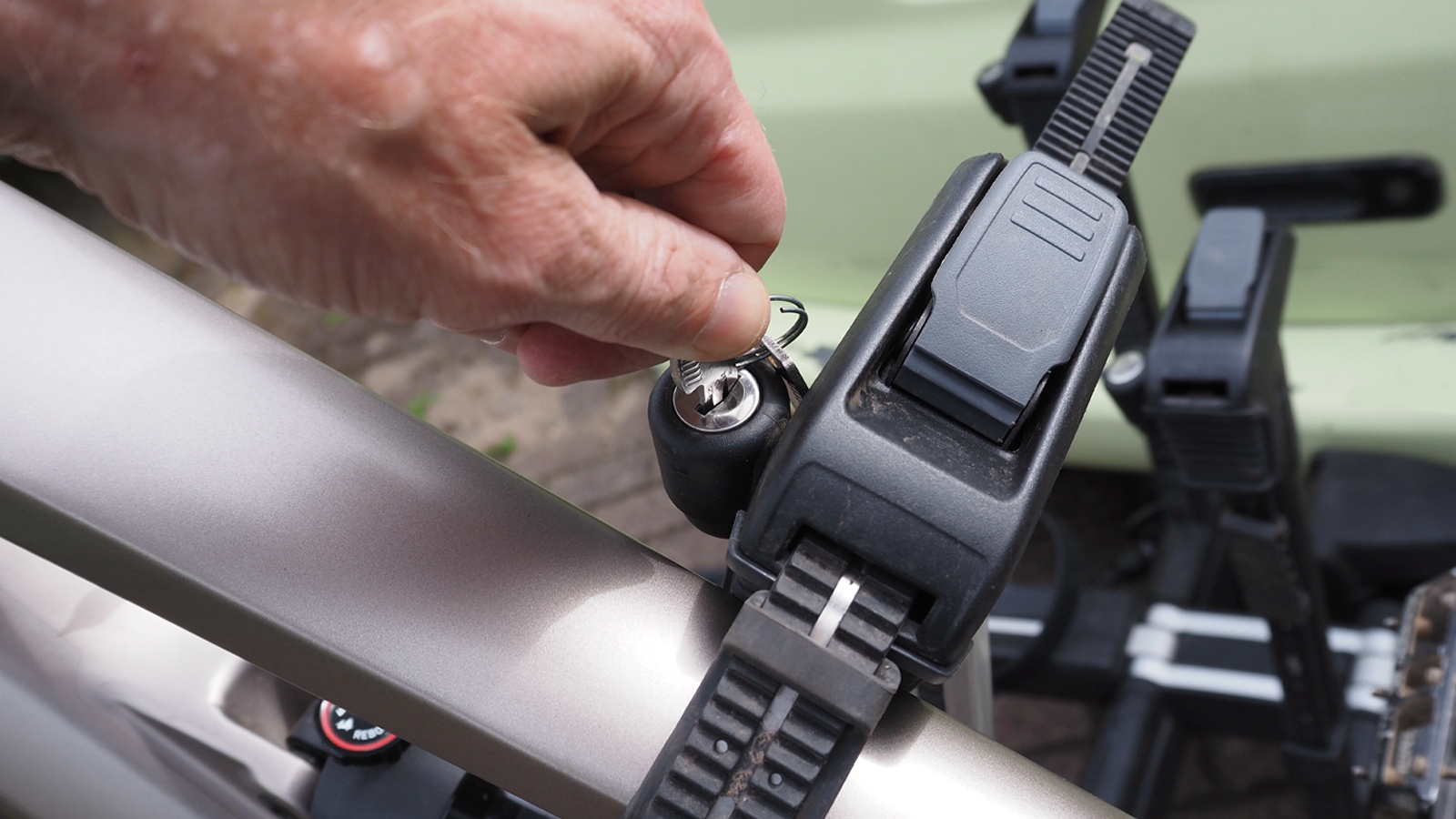
Verdict
There's no doubt that Thule has created an excellent bike carrier in the Epos, it's definitely the best I've ever tested, and ignoring its hefty weight, in terms of ease of use and secure mounting, there's nothing that can touch it.
It's also well designed for transporting e-MTBs, though the 60kg weight limit on the three-bike version means that you'll need to check your bike weights if you're looking to carry three e-MTBs. Three full-power bikes would overload it, but you may well be OK with a combination of light and/or midweight models.
Tech specs: Thule Epos bike rack
- Price: $1,099.99 / £1,099.99 / €1,099.99
- Weight: 23.2kg (three-bike model inc. lighting kit tested)
- Construction: Steel and aluminum with plastic straps and fixings
- Dimensions: 91 x 125 x 22cm (three-bike version)
- Folded dimensions: 91 x 27 x 75cm
- Weight capacity: 30kg per bike
- Maximum tire width: 3-inch
- Power connector: 13-pin
- Security: Carrier locks to tow hitch, lockable bike straps
- Test duration: 12 months







